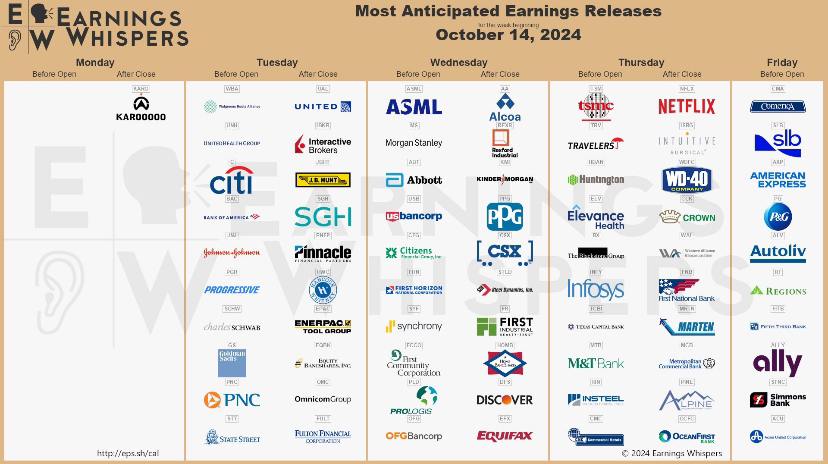Overnight profit (Earnings report trade).
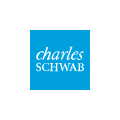
Charles Schwab Action Forum
ActionActionDiscussion sur SCHW
Postes
13$SCHW (+2,16 %) | Charles Schwab Q3'24 Earnings Highlights:
🔹 Adjusted EPS: $0.77 (Est. $0.75) 🟢
🔹 Net Revenue: $4.85B (Est. $4.78B) 🟢; UP +5% YoY
🔹 Net Interest Revenue: $2.22B (Est. $2.2B) 🟢
Client Metrics:
🔹 Total Client Assets: $9.92T (Est. $9.75T) 🟢; UP +27% YoY
🔹 Total Net New Assets: $90.8B
🔹 New Brokerage Accounts: 972,000 (Est. 1.02M) 😕
🔹 Total Active Brokerage Accounts: 35.98M (Est. 35.88M) 🟢
🔹 Daily Average Trades: 5.70M (Est. 5.71M) 😕
🔹 Revenue Per Trade: $2.20 (Est. $2.24) 😕
Operational Metrics:
🔹 Asset Management and Administration Fees: $1.48B (Est. $1.44B) 🟢
🔹 Trading Revenue: $797M (Est. $814.9M) 🔴
🔹 Bank Deposit Account Fees: $152M (Est. $144.2M) 🟢
Balance Sheet Metrics:
🔹 Bank Deposits: $246.5B (Est. $244.88B) 🟢
CEO Walt Bettinger's Commentary:
🔸 "Our momentum with clients continues to build following the successful completion of the Ameritrade conversion earlier this year. Third quarter net asset gathering of over $95 billion pushed year-to-date core net new assets to $252 billion – up 10% versus 2023 year-to-date."
🔸 "Record year-to-date flows into Schwab Wealth Advisory™ helped Managed Investing net flows reach $40 billion – an increase of 65% versus 2023 year-to-date. Converted Retail Ameritrade client interest in wealth solutions remains robust, accounting for approximately 35% of these flows."
"Robinhood Inc: savior of small investors or master of the silent raid?"
An introduction to the neo broker and a look at some figures.
Company presentation
Robinhood Markets, Inc. is a financial services company based in Menlo Park, California, founded in 2013 by Vladimir Tenev and Baiju Bhatt. It has made a name for itself primarily through its innovative, commission-free trading platform that democratizes access to stocks, ETFs, options and cryptocurrencies.
Historical development
With the vision of democratizing financial trading and making it accessible to everyone, Robin Hood got off to a rapid start. Within the first year, the company had already gained almost one million users and processed transactions worth over one billion US dollars. Since then, Robin Hood has developed into one of the defining players in the field of neo-brokerage, which continues to grow and set new standards.
Business model
Robinhood operates as an online broker and relies on a diversified business model. The main sources of revenue include:
- Order flow payments: Robinhood receives compensation from market makers for routing trade orders.
- Interest income on client balances: The company earns additional revenue through interest on deposits or credit card usage
- Premium subscription (Robinhood Gold): For a monthly fee, customers gain access to enhanced features and exclusive benefits.
Core competencies
At the heart of Robin Hood's business strategy is the provision of a user-friendly platform for trading financial instruments. This includes:
- Commission-free trading: users can trade stocks, ETFs, options and cryptocurrencies without transaction costs.
- Intuitive user interfaces: Both the mobile app and the web platform are characterized by their ease of use, which appeals to young, technology-savvy target groups in particular.
Future prospects and strategic initiatives
Robinhood is pursuing ambitious plans to further expand its offering and compete with established brokers. These include the trading of index options and futures, which are now available and will be expanded, as well as the expansion and extension of international markets.
Current performance of the Robinhood share
Over the year, Robinhood's shares have gained an impressive 98%, an increase that can be attributed to key internal company decisions. While shareholders who joined the company a year ago can be pleased with this development, the situation looks much bleaker for those who have been invested for three years. Even if you used a good cash tap at the time of the IPO, the share is still down 55% since August 26, 2021.
Development of the figures and future challenges
(Image 4&7)
Robinhood has recently been able to increase both its turnover and gross profit, and the company has even reported a positive net profit since the fourth quarter of December. Projects within the company are also progressing rapidly and the once negative reputation seems to be gradually improving. On the surface, therefore, everything seems to be going in the right direction - the company has achieved a turnaround and appears to be living up to increased expectations. However, caution is required, particularly with regard to two key factors: interest rate dependency and customer behavior.
Point 1: Sustainability of customer acquisition
One crucial aspect that causes concern is the issue of sustainability. Many Robinhood users are characterized by a high willingness to take risks, which often leads to losses. Given that the average account balance is currently around USD 4,000, this is an alarming sign, as the customer base is young and instead of saving capital for the long term, it is often gambled away. Previous measures to stop this trend have had little success, and initiatives such as the 401k plan have so far found little favor. Robinhood therefore remains highly dependent on the disincentives that lead to speculative behavior. If it is assumed that sustainable revenue can only be achieved by eliminating 25% of options trading and 50% of crypto trading, the company would quickly lose $151.25 million in revenue and find itself in a precarious position. So the question remains: can the business model be sustainable in the long term if it fails to fundamentally change its customer strategy?
(Image 9)
Point 2: Dependence on interest rates
Another potential problem is the heavy reliance on interest income, which accounts for 47% of total revenue - and not just this quarter, but for some time now. Even if part of this interest is of an operational nature and does not come solely from deposits or investments, it must be questioned whether Robinhood's approach as a broker can be successful in the long term. The situation is much more sustainable for established competitors. Without the interest income, Robinhood would clearly be in the red, which is problematic for a company of this size and structure. If interest rates were to halve, this would equate to a loss of revenue of USD 120.5 million.
(Image 5)
Conclusion
$HOOD (+5,61 %) has undoubtedly made progress, repositioned itself strategically and improved its position. However, major challenges remain that cannot be solved overnight. The customer base consists mainly of risk-taking speculators rather than long-term investors. In addition, the company lacks the necessary size and stability to survive major challenges without slipping back into the red. Of course, my assumptions are extreme - there is no immediate reason why 50% of crypto sales should suddenly collapse - but they illustrate that Robinhood has not yet been a reliable investment and has still not proven that it can be one in the long term. The risk remains high and it will take some time and further positive developments to overcome the existing problems. For me, Robinhood therefore remains a candidate for the watchlist to keep an eye on. It should not be forgotten that more and more competition will enter the market and the comparison with other brokers who are already delivering reliable figures and whose growth story is far from over.
(rest of the pictures)
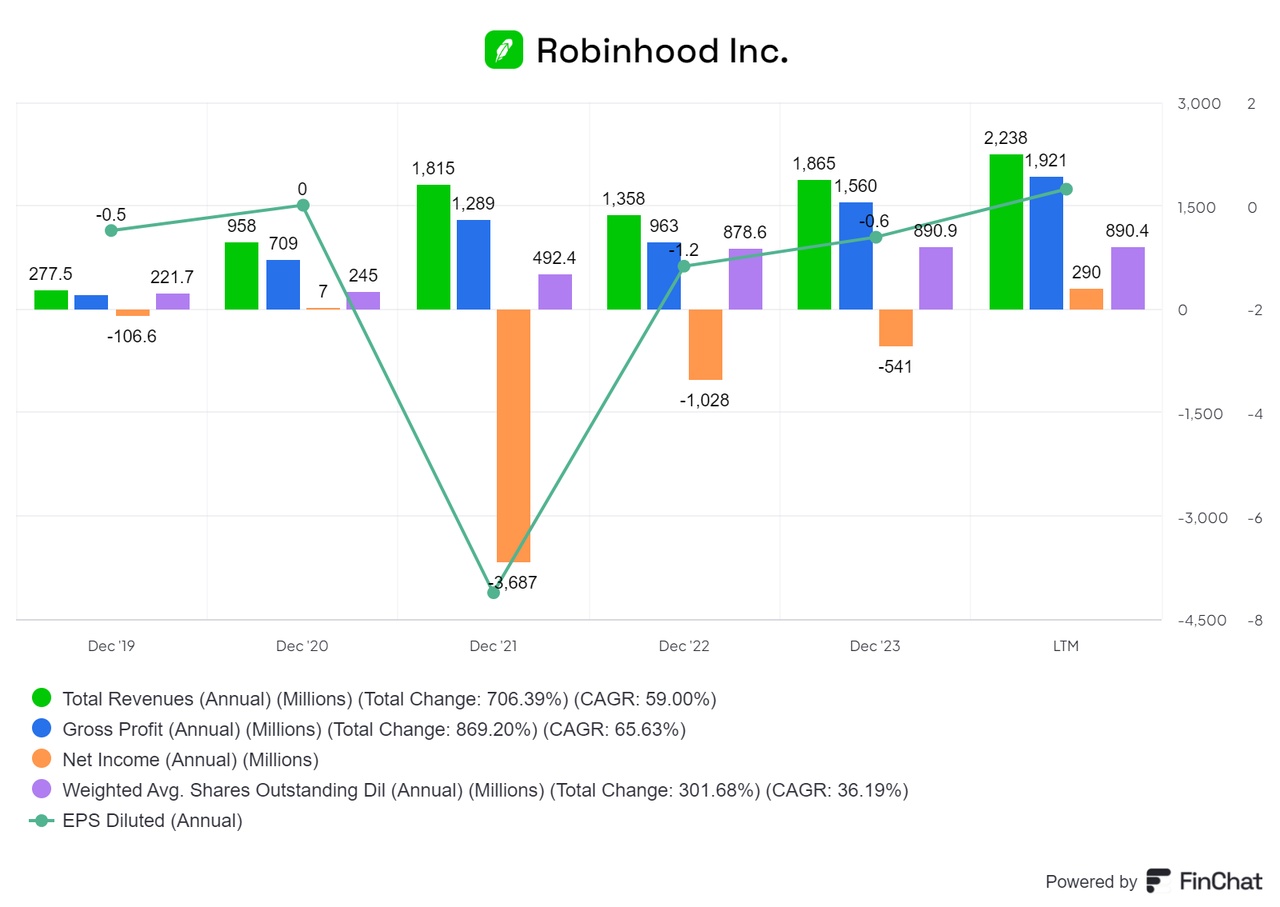
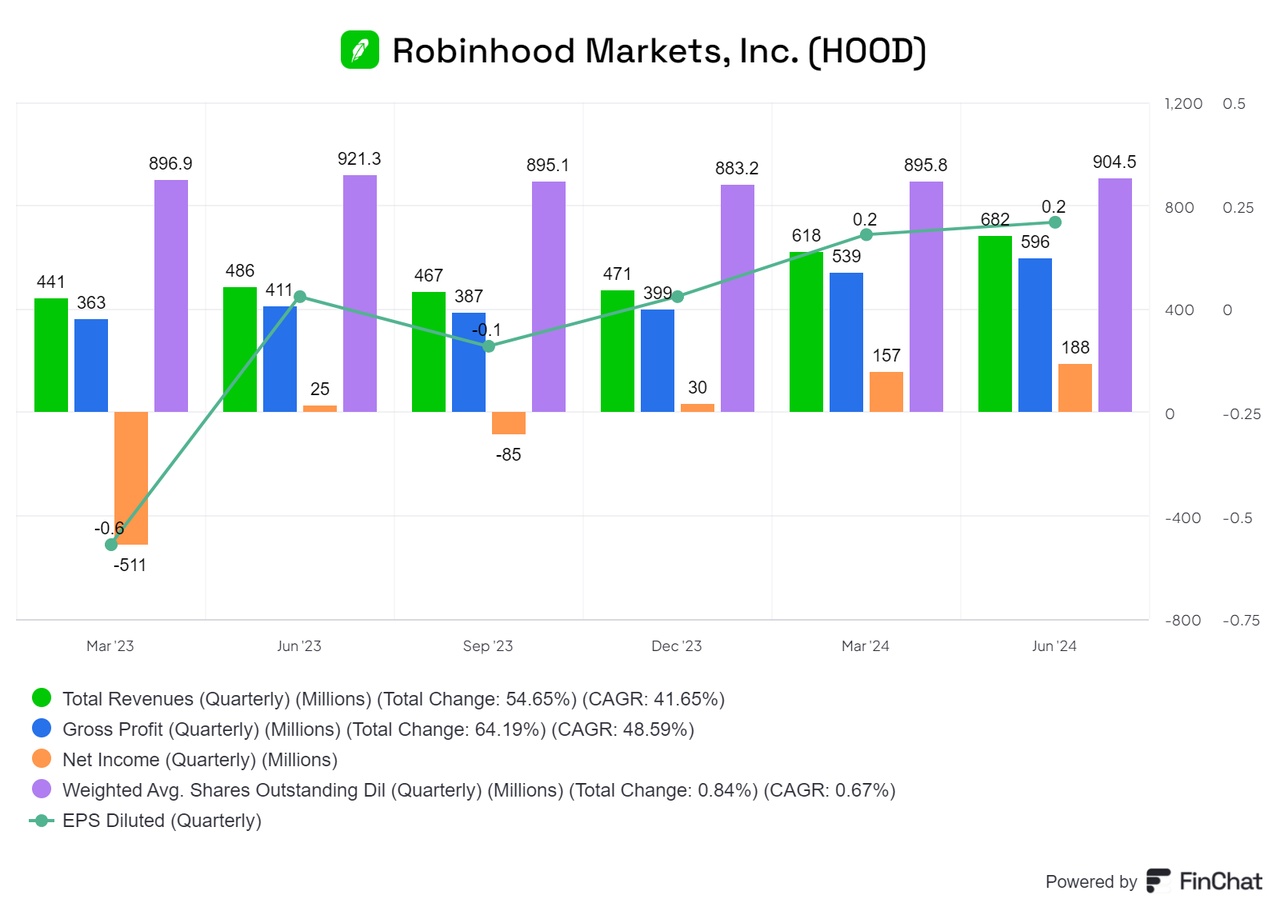
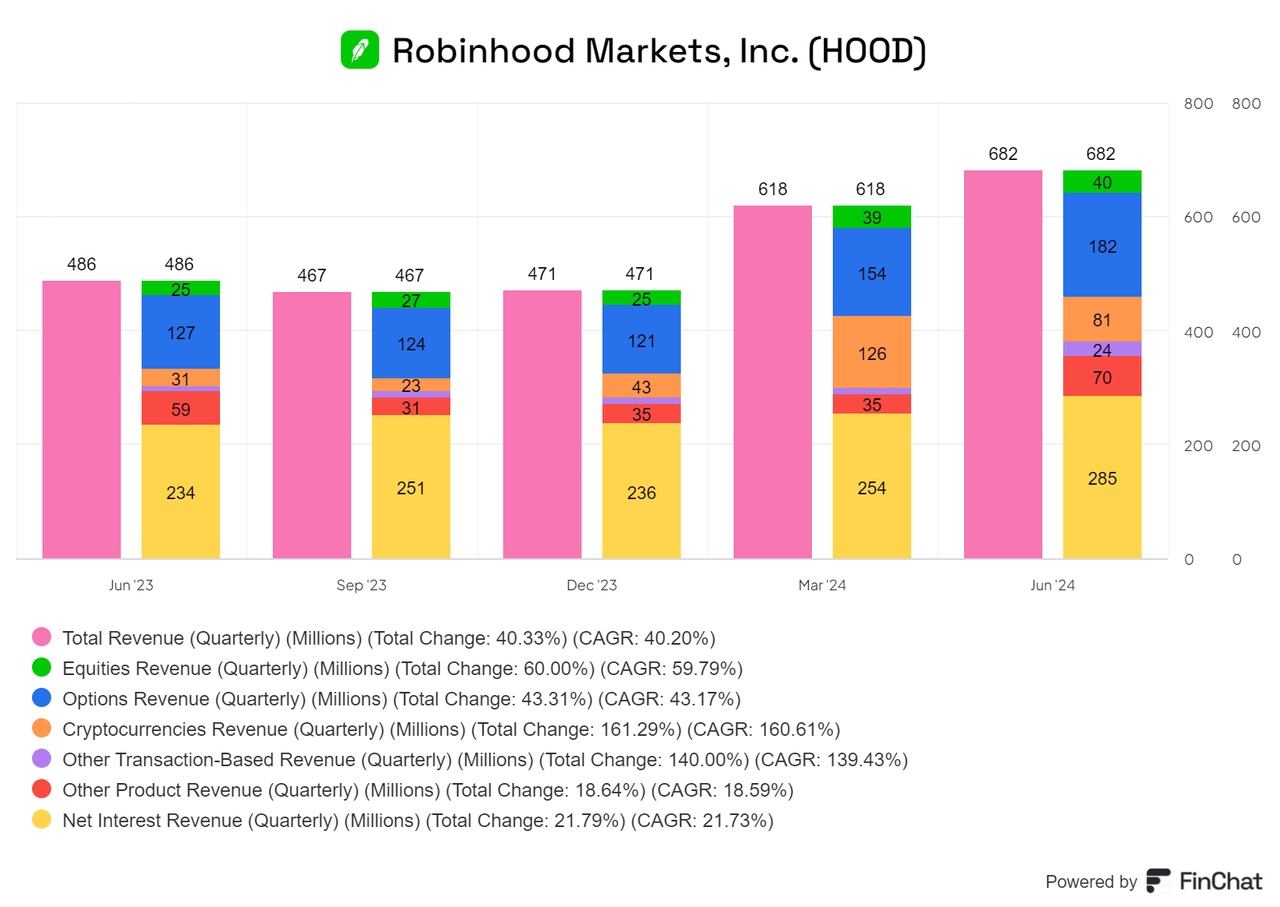
+ 5
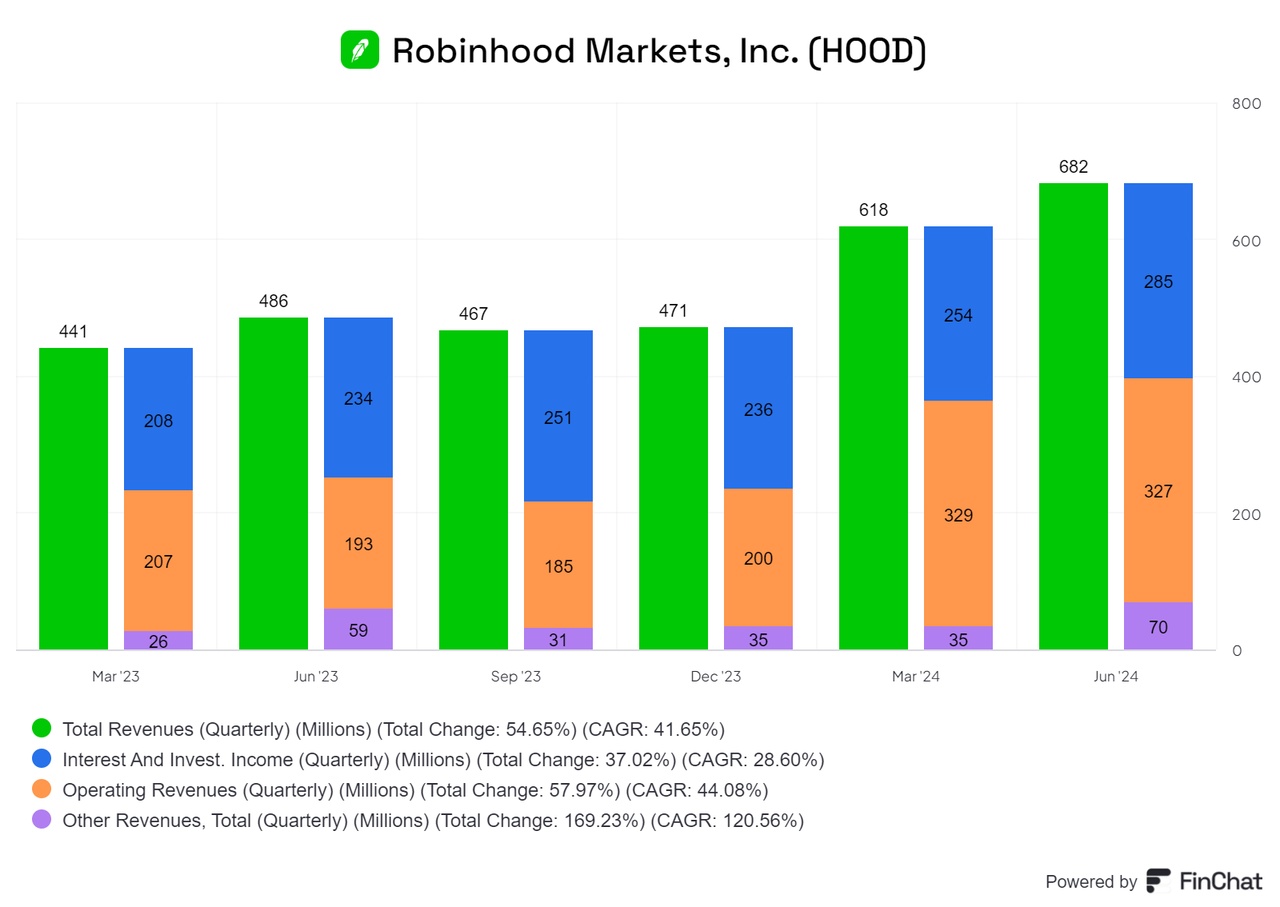
HOW TO FIND FUTURE DOMINANT TECH COMPANIES AT EARLY STAGES?
If we look at the 10 biggest USA companies in early 2000 and nowadays you'll notice that the chart is dominated by completely different companies.
Now it's obvious that Microsoft or Apple have a dominant position in the market, but what if we wanna understand before everyone else future market leaders? Are there any signs or specific metrics to look at?
If you look at many of these dominant companies at an early stages they often burned a lot of cash , they profit were negative and sometimes they also risked bankruptcy.
Amazon risked too fail different times because a lack of funds and the same happened to Apple.
So if I can't trust financial metrics how do I find them?
I think there is an interesting and insolite way to look at tech companies with messed up balance sheet and metrics but with great future possibilities.
You have to look to their innovations and if these innovations are so good that big leaders companies in the respective sectors try so hard to hemulate them you're probably facing a future dominant company.
Let's play this game with me and think for a second about all the big and small tech innovations a company makes that are suddenly copied by every big dog in the sector:
- The IPhone revolutionized the entire market and after that every smartphone company followed what Apple did.
- $V (+1,22 %) was founded in 1958 by Bank of America and when other banks understood the potential they all coalized to create $MA (+0,88 %) in 1966.
- Auto manufacturers tried so hard to create a car model to compete with $TSLA (+9,97 %) innovative concept of cars.
- $ALGN (-0,85 %) orthodontic innovation was immediatly copied by many health competitors.
All these companies have 2 things in common:
- At the beggining their products or services were used and understood by a small public (sometimes even mocked at)
- They have all returned way more than 10x returns since big competitors tried to copy them.
If we apply this theory to today's stocks market I can find similar stories at relative early stages with a stock price that it's still not multiplied.
One new company brings innovation and the "old dogs" in the room try to implement their ideas in their products:
- $HOOD (+5,61 %) shacked the trading market so hard that big old name like $SCHW (+2,16 %) decided to buy Ameritrade for 26 bln dollar in order to compete with this new app, but with bad results. $MS (+1,35 %) also bought a "smaller" competitor to keep up with Robin Hood innovation.
- $ABNB (-6,51 %) has has been literally copied through the years by Vrbo (owned by $EXPE (+1,46 %) ). $BKNG (+1,31 %) himself has also started to gradually increase is short term leases offers on his app entering in Airbnb market segment.
- Microsoft is trying hard to hemulate what $PLTR (+5,8 %) software is able to do.
Do you know any other companies that could fit into these criterias?
I' d love to listen to your observations or constructive criticism ☺️
Please bear in mind that these are just my considerations and they can be absolutely wrong.
The week will be pure entertainment.
Monday:
- Release of the Empire State Manufacturing Index (July)
- Start of the Republican National Convention
- Statements by FED Chair Jerome Powell and San Francisco
Fed President Mary C. Daly - Quarterly results from Goldman Sachs ($GS (+2,22 %) ), BlackRock ($BLK ) and Servis1st Bancshares ($SFBS )
Tuesday:
- Start of the ⚠️Amazon Prime Day⚠️
- Continuation of the Republican National Convention
- Publication of retail sales (June), business inventories (May), import/export prices (June) and the real estate market index (July)
- Quarterly results from UnitedHealth ($UNH (+3,09 %)), Bank of America ($BAC (+1,3 %)), Morgan Stanley ($MS (+1,35 %)), Charles Schwab ($SCHW (+2,16 %)), PNC Financial ($PNC (+1,07 %)), State Street ($STT (-0,14 %)) and J.B. Hunt Transport ($JBHT (+2,61 %))
- Statements by FED Governor Adriana Kugler
Wednesday:
- End of of the ⚠️Amazon Prime Day⚠️
- Continuation of the Republican National Convention
- Publication of housing data (June) and industrial production (June)
- Publication of the FED Beige Book
- Quarterly results from Johnson & Johnson ($JNJ (+0,03 %)), US Bancorp ($USB (+2,13 %)), Kinder Morgan ($KMI (+2,78 %)) and Discover Financial Services ($DFS (+0,81 %))
Thursday:
- Publication of the weekly Jobless Claims (until July 13)
- Publication of of the Philadelphia Fed Manufacturing Index (June)
- Quarterly results from TSMC ($TSM (+0,91 %)), Netflix ($NFLX (+0,37 %)), Novartis ($NVS (+0,2 %)), Abbott ($ABT (+2,48 %)), United Airlines ($UAL (+3,22 %)) and Intuitive Surgical ($ISRG (+2,71 %))
- ⚠️Abschluss of the Republican National Convention with speeches by Donald Trump (not sure)⚠️
Friday:
- Quarterly results from American Express ($AXP (+0,52 %)), Travelers Cos. ($TRV (+2,63 %)), Halliburton ($HAL (-0,29 %)), Fifth Third Bancorp ($FITB (+1,7 %)), Huntington Bancshares ($HBAN (+0,19 %)) and Regions Financial ($RF (+0,84 %))
- Statements from New York
FED President
John C. Williams and Atlanta Federal Reserve President Raphael Bostic

Here is a summary of important events & the Formatting is Getquin's fault!
US MARKET🇺🇸
Monday
Publication of the Empire State Manufacturing Survey of the New York Fed for April.
Publication of the retail sales in the USA for March.
Publication of the business inventories for February.
Publication of the homebuilder confidence for April.
Speeches by Lorie LoganPresident of the FED of Dallasand Mary C. DalyPresident of the FED Bank of San Francisco.
Quarterly reports from Goldman Sachs ($GS (+2,22 %) ), Charles Schwab ($SCHW (+2,16 %) ) and M&T Bank ($MTB (+1,41 %) ).
Tuesday
Publication of the building permits for March.
Publication of the industrial production for March.
Quarterly reports from UnitedHealth Group ($UNH (+3,09 %) ) , Johnson & Johnson ($JNJ (+0,03 %) ), Bank of America ($BAC (+1,3 %) ), Morgan Stanley ($MS (+1,35 %) ), BNY Mellon ($BK (+0,21 %) ) and PNC Bank ($PNC (+1,07 %) ).
Wednesday
Publication of the mortgage applications for the week ending April 12.
Publication of the FED Beige Books.
Quarterly reports from United Airlines ($UAL (+3,22 %) ), Abbott Laboratories ($ABT (+2,48 %) ), U.S. Bancorp ($USB (+2,13 %) ), Travelers Cos. ($TRVC34 ), Citizens Financial ($FCNCA (+0,5 %) ), First Horizon ($FHN (+1,66 %) ) and Discover Financial Services ($DFS (+0,81 %) ).
Thursday
Publication of initial jobless claims for the week ending April 13.
Publication of the Philadelphia Fed Manufacturing Survey for April.
Release of existing home sales for March.
Speeches by John C. WilliamsPresident of the FED of New Yorkand Raphael BosticPresident of the FED of Atlanta.
Quarterly reports from Netflix ($NFLX (+0,37 %) ), Intuitive Surgical ($ISRG (+2,71 %) ) and Infosys ($INFY ).
Friday
Speech by Austan GoolsbeePresident of the FED of Chicago.
Quarterly reports from Procter & Gamble ($PG (+3,31 %) ), American Express ($AXP (+0,52 %) ), Fifth Third Bancorp ($FITB (+1,7 %) ) and Huntington Bancshares ($HBAN (+0,19 %) ).
Saturday
Possible events in connection with the Bitcoin halving.
EU MARKET
Monday
Release of industrial production
Speech by Philip Lane, Member of the Executive Board of the ECB
Quarterly reports from Pagegroup ($PAGE (+22,02 %) ) 🇬🇧, Playtech $PTEC (-0,29 %) ) 🇬🇧
Tuesday
Trade Balance (Feb)
ZEW Economic Sentiment
Eurogroup Meetings
Publication of the quarterly reports of Ashmore ($ASHM (-0,23 %) ) 🇬🇧
Wednesday
Publication of CPI data
EU Summit & Eurogroup Meetings
Speech by Isabel Schnabel, Member of the Executive Board of the ECB
Quarterly figures from Severstal ($CHMF ) 🇷🇺, Volvo B ($VOLV B (-3,37 %) ) 🇸🇪, Viscofan $VIS (+1,06 %) ) 🇪🇸, Petershill Partners ($PHLL ) 🇬🇧, Hays ($HAS (-1,04 %) ) 🇬🇧
thursday
Speech by Luis de GuindosVice President of the ECB
EU Summit & Eurogroup Meetings
Speech by Isabel Schnabel, Member of the Executive Board of the ECB
- Quarterly figures from EQT AB ($EQT (-2,29 %) ) 🇸🇪, EssilorLuxottica ($EL (+0,83 %) ) 🇫🇷, Nordea Bank ($NDA FI (-0,25 %) ) 🇸🇪, Sartorius Stedim ($DIM (-1,61 %) ) 🇩🇪, Nokia Oyj $NOKIA (-0,81 %) ) 🇫🇮, Inter Cars SA ($n/a) 🇵🇱, Tauron Polska Energia ($TPE (+1,04 %) ) 🇵🇱, Forvia ($FRVIA (-2,55 %) ) 🇫🇮, Dunelm ($DNLM (+0,75 %) ) 🇬🇧, Adtran Networks SE ($ADV (+0 %) ) 🇩🇪, Olvi Oyj A ($OLVAS (-0,17 %) ) 🇫🇮, Econocom ($ECOM ) 🇧🇪, Talenom Oyj $TNOM (+2,33 %) ) 🇫🇮, Alisa Pankki Oyj ($ALISA (-0,42 %) ) 🇫🇮
Friday
Eurogroup Meetings
CFTC EUR speculative net positions
Quarterly figures from Sodexo ($SW (+0,51 %) ) 🇫🇷, Linea Directa Aseguradora ($LDA (-3,21 %) ) 🇪🇸, Alma Media ($002950 ) 🇫🇮, Gofore ($GOFORE (+1,34 %) ) 🇫🇮

An overview of the dismissals (last 3 months), via Twitter.
- Twitch: 35%
- Hasbro: 20%
- Spotify ($SPOT (+0,87 %) ): 17%
- Levi's: 15%
- Zerox ($ZEROX (-0 %) ): 15%
- Qualtrics ($XM ): 14%
- Wayfair ($W (-1,95 %) ): 13%
- Duolingo: 10%
- Washington Post: 10%
- eBay ($EBAY (+0,56 %) ): 9%
- Business Insider: 8%
- Charles Schwab ($SCHW (+2,16 %) ): 6%
- Macy's ($M (-3,93 %) ): 4%
- Blackrock ($BLK ): 3%
- Citigroup ($C (+1,33 %) ): 20,000
- UPS ($UPS (-0,58 %) ): 12,000
- Pixar: 1,300
- Salesforce ($CRM (+4,64 %) ): 700
- American Airlines: 650
- PayPal ($PYPL (+3 %) ): 2,500

Titres populaires
Meilleurs créateurs cette semaine



